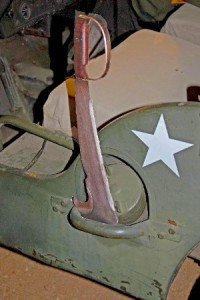Post
The Woodman’s Pal
Hunting Articles & Stories admin PM

From Military Weapon to
Can’t-Do-Without Peacetime Tool.
As the Holy Bible says in Isaiah 2:4, “They shall beat their swords into plowshares and their spears into pruning hooks.” The proof of this prophecy is the handcrafted Woodman’s Pal, which has more peacetime uses than any-other implement of war. Like the American soldier, the Woodman’s Pal has gone to war, returned home and adapted itself to society as a tool of peace. Today, the Woodman’s Pal continues to serve the men and the women who have carried it while fighting in combat.
Since 1941, our fellow countrymen and women often have been called-up to defend this nation’s freedom, and the Woodman’s Pal has gone with them to foreign lands to protect and support the U.S. Armed Forces. Manufactured of American-made steel and American-grown ash and fashioned the same way in the U.S.A. for almost 70 years by craftsmen, the Woodman’s Pal, unlike many-other American tools, never has become obsolete or has had to be replaced with a better or a more advanced product.
During the United States’ involvement in World War II, beginning in 1941 and lasting until 1945, many soldiers carried the Woodman’s Pal, or in military terms, the LC-14-B. Soldiers used this machete-type tool to defend themselves against attacks by swords, bayonets, and machetes in hand-to-hand combat. It also was used to open coconuts, clear paths through the jungles, slash through vines and cut materials for camouflage.
The Woodman’s Pal involvement with the U.S. Armed Forces began in 1941 when architect and engineer Frederick Ehrsam designed the tool. Once the U.S. military learned of this new knife/tool, it became a standard military issue in all the nation’s wars through the Gulf War, which ended in 1991. U.S. soldiers and the U.S. Army Signal Corps relied heavily on the Woodman’s Pal through the years for land-clearing operations. At the time of the Vietnam War, the Woodman’s Pal, which was issued in air-crew survival kits, was designated “Survival Tool, Type IV” and was commonly known by soldiers as the Jungle Fighting Knife.
Originally, the Woodman’s Pal was designed as a tool to enable individuals to clear their way into the wilderness where man met nature. However, when World War II started, the design of the Woodman’s Pal changed slightly, so that it could serve as a weapon, as well as a brush-clearing tool. After the war, many servicemen brought their Woodman’s Pals home and used them for trimming brush, pruning limbs from trees, landscaping, blazing trails, clearing firebreaks, building duck blinds, removing vines and slashing through thorns and bushes around their homes.
Handcrafted at Pennsylvania’s Pro Tool Industries, the Woodman’s Pal, once a tool of war has become a very-unique tool of peace. Outdoorsmen still can purchase the Woodman’s Pal today in many farming-supply stores, hardware stores and stores that sell gardening and land-clearing equipment, as well as through the Internet. This unique hand tool has served military men and women and civilians for decades and continues to provide the same high quality of dependable performance today. When you own a Woodman’s Pal, you not only have a piece of military history, but also a very efficient tool to use around the home, the garden, the hunting camp and anywhere else in the great outdoors.
You can receive a free copy of “Fighting with the U.S.A. Knife LC-14-B,” written by its creator Frederick Ehrsam, and learn more about the military history of the U.S.A. by visiting Pro Tool Industries’ webpage, www.protoolindustries.net/signup and completing the order form. Or, you can send a self-addressed stamped envelope to Pro Tool Industries, 337 Circle of Progress Drive, Pottstown, PA 19464, and request this free booklet that was tucked into an inner pocket in the LC-14-B’s sheath when the knives were distributed to military personnel. It includes illustrated instructions on using this tool.
